|
 Bright Start Blog
|
|
Case Study - Julian is a Mermaid
Using fiction to spark children's interest and imagination by Constance Handley
|
|
|
Five minute read
- How can we develop children's interest in dressing up?
- What difference does it make when we introduce a text to support creativity and imagination?
- How can trips out of the setting further embed and extend learning?
|
|
Constance Handley, Nursery Teacher at Willow Children's Centre shares the development of a creative and inclusive project. |
|
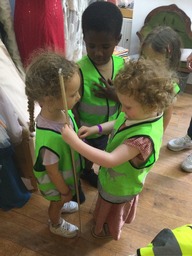
Spark
Through our observations of the children in nursery and communication with families we knew that they all had a deep interest in costume and dressing-up. Boys and girls equally enjoyed visiting the dressing up selection in the home corner, experimenting with the variety of colourful, sparkly fabrics, outfits and accessories there to express themselves. We also noticed that many children brought costumes in from home to wear and share during the day. These costumes often led to and extended the children’s imaginative play, but more pertinently seemed to provide children with a new confidence and sense of self-expression, giving them opportunity to play with who they wanted to be that day.
|
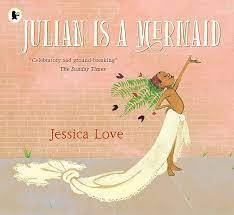
Provocation
Initially we started adding a variety of open-ended fabrics to the home corner to encourage the children to create their own outfits and costumes, which they responded to with enthusiasm. However, we noticed that after a while the children were using the same simple tying techniques to create mainly simple strapless dresses and skirts.
We chose to introduce the story Julian is a Mermaid by Jessica Love, in which the main character creates his own mermaid costume using items he finds around the home. It was important to us that the story celebrates a genderless approach to dress up, and the way that clothing and costume can empower people to feel themselves and find community. I read the story, performing it to the children with props and sharing a video of the real Coney Island Mermaid Parade which inspired the story.
|
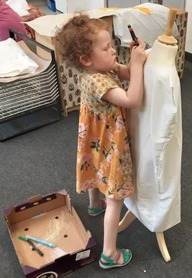
Response
The children were entranced by the story and video and many immediately responded by making their own headdresses using strips of paper and collage materials (pompoms, buttons, sparkly strands, tissue paper). They used measuring tape to measure their heads and ensure that their headdresses would be the correct size. This interest in measuring and techniques led me to get in touch with the City and Islington College fashion department about visiting their students and studios. Mita Pandya (Executive Head of Nursery) also reached out to a local tailor. At C&I the children were given a tour of the end of year fashion exhibition by a lecturer and a student. They learned about the variety of techniques you can use to make clothing, and how you can turn inspiration (such as graffiti) into a garment. At the tailor, the children learned about the amazing techniques and equipment you can use to edit and create your own clothing.
In response to this we purchased a tailor’s mannequin which the children started to use with the fabric we had previously provided in the home corner. They created amazing transient pieces, experimenting with overlapping, wrapping, pegging, tying and twisting.
We also visited the Victoria and Albert Museum to observe the beautiful jewellery and fashion collections there. The children were able to explore pieces from around the world, throughout history. They observed with great interest how men’s and women’s fashion changes across time and were amazed by the richness of much of the clothing and jewellery.
|
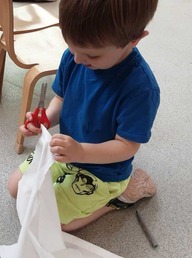
Final outcome
Each child was given a pillowcase as a blank slate for them to create their own design. They started off by cutting their neck and armholes into whichever shapes they preferred, before painting them with their chosen design and pattern. One child was inspired by her recent family trip to Rome and decided to use this in her design, cutting and twisting the fabric into a toga shape. Finally they embellished them with fabric, making further edits to the shape, style and design. Throughout the process we encouraged the children to think ahead about their intention with their design, drawing the inspiration we have seen in, whilst also encouraging them to reflect on how things worked out.
|
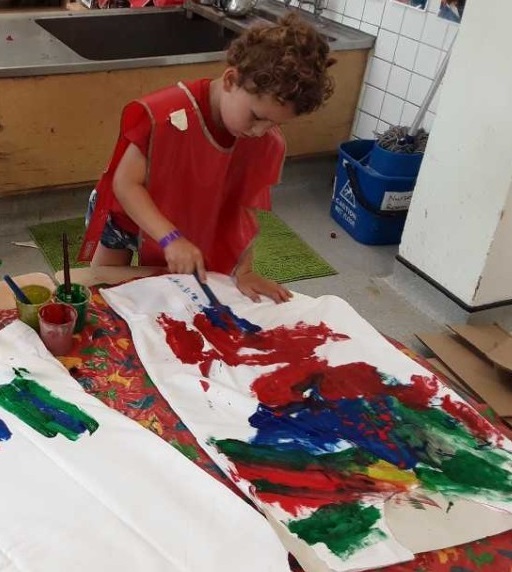
|
|
Constance Handley is a nursery teacher at Willow Children’s Centre in Islington and has been teaching for eight years. Her strong belief in the importance of the early years in children’s lives has been further deepened by a recent Master’s degree in Early Years Education from UCL for which she received a distinction. Constance is passionate about using the arts as a method of expression and exploration with young children and families, and believes this is particularly powerful when used in conjunction with stories. Constance believes in the innate richness of children and the importance of listening to them and their inspiring ideas as we learn through play together. She has enjoyed bringing her practice home on a personal level with her young son, Robin, who is 15 months old. |
|
|
|